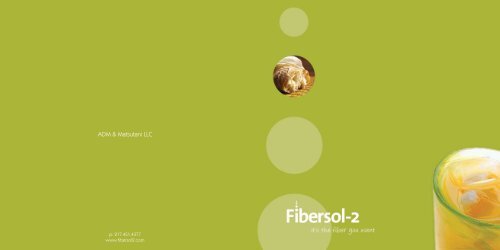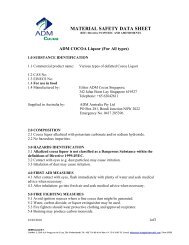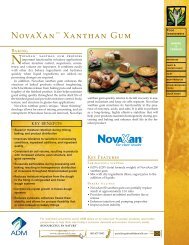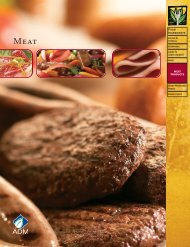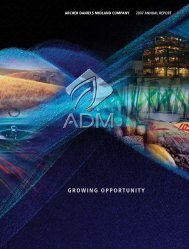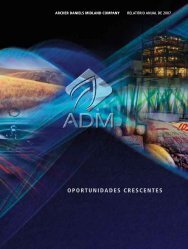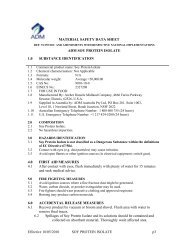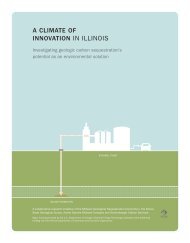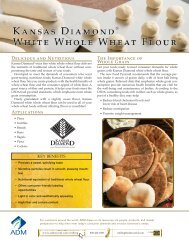Fibersol-Technical-Brochure - ADM
Fibersol-Technical-Brochure - ADM
Fibersol-Technical-Brochure - ADM
You also want an ePaper? Increase the reach of your titles
YUMPU automatically turns print PDFs into web optimized ePapers that Google loves.
<strong>ADM</strong> & Matsutani LLC<br />
p: 217.451.4377<br />
www.fibersol2.com
Make sure you choose the<br />
right fiber when developing<br />
your product formulations!<br />
<strong>Fibersol</strong>-2 is the fiber you<br />
want to make your foods and<br />
beverages healthier without<br />
any of the typical formulation<br />
and taste issues found with<br />
other fiber sources!<br />
nutritional information®<br />
Feeding studies in animals and humans spanning more than 15 years have shown<br />
the impact of <strong>Fibersol</strong>-2 ® digestion resistant maltodextrin as an ingredient that helps<br />
to maintain intestinal regularity and help retain healthy serum triglycerides. Although<br />
<strong>Fibersol</strong>-2 digestion resistant maltodextrin is made from corn starch, data suggests that<br />
<strong>Fibersol</strong>-2 digestion resistant maltodextrin itself may not cause an appreciable increase<br />
in blood glucose levels following consumption. Thus unlike maltodextrin or glucose,<br />
<strong>Fibersol</strong>-2 digestion resistant maltodextrin would be useful in foods formulated to<br />
create minimal increases in post meal blood glucose levels.<br />
Nutrient<br />
Total Calories<br />
Total Fat<br />
Saturated Fat<br />
Trans Fat<br />
Polyunsaturated Fat<br />
Monounsaturated Fat<br />
Cholesterol<br />
Sodium<br />
Potassium<br />
Total Carbohydrate<br />
Dietary Fiber<br />
Soluble Fiber<br />
Insoluble Fiber<br />
Sugars<br />
Sugar Alcohol<br />
Other Carbohydrate<br />
Protein<br />
Vitamin A<br />
Vitamin C<br />
Calcium<br />
Iron<br />
Moisture<br />
Per 1 gram of ingredients<br />
1.6kcal/g<br />
0.00 g<br />
0.00 g<br />
0.00 g<br />
0.00 g<br />
0.00 g<br />
0.00 mg<br />
0.01 mg<br />
0.00 mg<br />
0.96 g<br />
0.90 g<br />
0.90 g<br />
0.00 g<br />
0.02 g<br />
0.00 g<br />
0.04 g<br />
0.00 g<br />
0 IU<br />
0 IU<br />
0.00 g<br />
0.00 g<br />
0.04 g<br />
it’s the fiver you want<br />
The scientifically determined energy value for <strong>Fibersol</strong>-2 is 1.6 kcal/gram. When calculating<br />
energy content of complex foods containing <strong>Fibersol</strong>-2, use 1.4 kcal/g for the fiber portion<br />
contributed by <strong>Fibersol</strong>-2 as measured by AOAC 2001.03. Note that this rounded value yields<br />
a lower than actual <strong>Fibersol</strong>-2 energy value when applying the energy factors for carbohydrate/<br />
protein/fat/fiber to the typical composition values provided.
formulation benefits<br />
Soluble Dietary Fiber:<br />
90% minimum DSB soluble dietary fiber (in<br />
accordance with AOAC method #2001.03) and<br />
one of the most economical fiber sources available.<br />
<strong>Fibersol</strong>-2 digestion resistant maltodextrin analytically<br />
No Inherent or Added Flavors:<br />
<strong>Fibersol</strong>-2 digestion resistant maltodextrin adds<br />
no flavor or odor making it suitable for use in even<br />
delicately flavored applications.<br />
Very Low Viscosity:<br />
A precise and extremely low viscosity (15 cps, 30%<br />
solution at 30° C), allowing use rates in excess of 10%<br />
without direct impact on the mouthfeel, flavor and other<br />
sensory performance requirements.<br />
<strong>Fibersol</strong>-2<br />
makes it easy to<br />
develop and formulate<br />
healthier food<br />
and beverages<br />
meets the definition of dietary fiber for nutrition<br />
Improves Flavor, Performance of High-Intensity<br />
labeling purposes, as published by the American<br />
Sweeteners:<br />
Low Hygroscopicity:<br />
Association of Cereal Chemists (AACC). Nutritionally<br />
Modifies and improves the sweetness and aftertaste<br />
Very low tendency to pick up moisture from the air. This<br />
<strong>Fibersol</strong>-2 meets the criteria accepted to define<br />
performance of many high-intensity sweeteners,<br />
makes for ease of use in handling and delivery to point<br />
dietary fiber as determined by the Institute of<br />
allowing for flavor, sweetness and mouthfeel<br />
of use and can effectively protect dry blends with other<br />
Medicine in the 2002 Dietary Reference Intakes<br />
improvements to a variety of low-calorie foods.<br />
hydroscopic ingredients.<br />
Report for Fiber*.<br />
Low Sweetness:<br />
Binds Water:<br />
High Solubility:<br />
Has essentially no sweetness of its own. Can be used<br />
Also releases bound water easily, adding perceived<br />
Totally soluble in water<br />
in many applications where additional sweetness is<br />
moistness to a variety of applications including low<br />
up to 70% (w/w) at<br />
undesirable. Acid and Heat/Retort Stable: Stability to<br />
water activity products. Resists Browning: Due to its low<br />
20° C, allowing it to<br />
acid and heat/retort processing—including stability in<br />
dextrose equivalence it does not appreciably catalyze<br />
be solubilized in<br />
high acid, hot filled, aseptic or retorted products like<br />
non-enzymatic Maillard-type browning.<br />
small amounts of<br />
juices, sauces, puddings, fluid milks and sports drinks<br />
water as needed.<br />
— is unique. It retains its dietary fiber characteristics<br />
* “Dietary, Functional and Total Fiber” in Dietary Reference Intakes for<br />
Rapid Dispersion:<br />
Readily dispersible in<br />
and function across process and postprocess<br />
distribution conditions.<br />
Energy, Carbohydrate, Fiber, Fat, Fatty Acids, Cholesterol, Protein and<br />
Amino Acids, Ch. 7, The National Academies Press (Washington, D.C.),<br />
pp. 339-421.<br />
water and highly compatible with dry drink mix<br />
Superior Freeze/Thaw Stability:<br />
applications, including simple and more complex<br />
Flavor, function and performance of dietary fiber<br />
codried or dry blended mixes.<br />
content are stable to repeated freezing and thawing<br />
when stressed due to distribution abuse or when used<br />
Clear, Transparent Solution:<br />
in a variety of frozen foods.<br />
At typical use levels it yields clear, transparent<br />
solutions that are near water-like in performance.<br />
This allows for ultimate formulation versatility.
labeling information<br />
Ingredient Statement<br />
Digestion Resistant Maltodextrin<br />
Resistant Maltodextrin<br />
Maltodextrin<br />
Nutrient Content Claims<br />
• “Good source” claim = 10+% DV = 2.5 g total dietary<br />
fiber per serving = 2.8 g <strong>Fibersol</strong> ® -2 as is per serving<br />
(assumes <strong>Fibersol</strong>-2 is sole source of dietary fiber)<br />
make a healthy statement by adding fiber to your products<br />
Physical Characteristics<br />
Color: Off-white powder; clear, transparent in 10% solution;<br />
resists both enzymatic and non-enzymatic browning.<br />
Flavor: No flavor, clean<br />
Solubility: Water soluble up to 70% (w/w) at 20° C<br />
Dispersibility: Excellent<br />
Hygroscopicity: Very low<br />
Stability: Acid, heat/retort processing and freeze/thaw stable<br />
Viscosity: Very low; 15 cps, 30% solution at 30° C<br />
Sweetness: Low, no sweetness<br />
Bulk Density: Approx. 0.48 g per ml (30 lbs. per cubic foot)<br />
Typical Chemical Properties<br />
Water-soluble dietary fiber*: 90% minimum DSB (in<br />
accordance with AOAC method #2001.03)**<br />
Moisture: 5% maximum<br />
Protein: None<br />
Fat: None<br />
Ash: 0.2% maximum<br />
DE: 8 -12.5<br />
Acidity: pH 4.0-6.0<br />
Carbohydrate profile (% of total carbohydrate)<br />
DP1: 0.5%<br />
DP2: 1.5%<br />
DP3: 4.0%<br />
DP4 - 6: 24.0%<br />
DP7+: 70.0%<br />
• “Excellent source” claim = 20+% DV = 5.0 g total dietary<br />
fiber per serving = 5.6 g <strong>Fibersol</strong>-2 per serving (assumed<br />
<strong>Fibersol</strong>®-2 is sole source of dietary fiber)<br />
• In support of nutrient content claims, factors such as the<br />
amount of total fat, saturated fat, cholesterol and sodium<br />
in the finished food must be taken into account to allow<br />
a claim. Standard of identity must be properly identified<br />
when incorporating <strong>Fibersol</strong>-2 into any application.<br />
Additional qualifications apply.<br />
Structure/Function Claims<br />
• In support of structure/function claims, typically, a<br />
minimum 6.0+ g <strong>Fibersol</strong>-2 as is per serving is needed<br />
to couple back to existing and ongoing clinical research.<br />
Factors such as amount of total fat, saturated fat,<br />
cholesterol and sodium in the finished food to which<br />
<strong>Fibersol</strong>-2 is added need to be taken into account to<br />
allow a claim. Customer assumes all final responsibility for<br />
claim support of their product.<br />
* <strong>Fibersol</strong>-2 digestion resistant maltodextrin is a dietary fiber. This classification is<br />
consistent with both the American Association of Cereal Chemists’ and the Food<br />
and Nutrition Board of the National Academy of Sciences’ (NAS) definitions of<br />
dietary fiber. In both cases, <strong>Fibersol</strong>-2 digestion resistant maltodextrin is classified<br />
as “resistant maltodextrin,” and in both cases, “resistant maltodextrin” is classified<br />
as a dietary fiber.<br />
** In April 2001, AOAC formally approved analytical methodology (“Determination<br />
of Total Dietary Fiber and Resistant Maltodextrin in Select Foods by Combination of<br />
Enzyme-Gravimetric and LC,” AOAC method #2001.03), which measures digestion<br />
resistant maltodextrin


